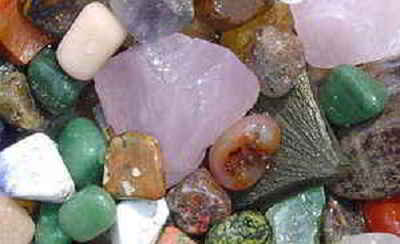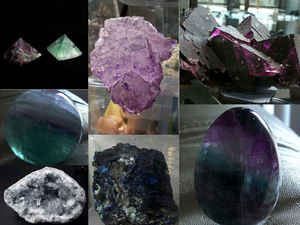
Tennessee Symbols
Tennessee State Mineral
Tennessee Agate

(SiO2 - Silicon Dioxide)
Adopted on April 2, 2009
Agate is a cryptocrystalline quartz. This semiprecious gemstone is found in only a few areas of the state. The agate was adopted as the official state "stone" of Tennessee by House Joint Resolution No. 42 on March 25, 1969 and later re-designated as the official state mineral in 2009.
The agate was chosen to represent the State of Tennessee twice; first as the state "stone" and forty years later, after adoption of an
official state gem and an official state rock, the General Assembly thought that some clarification was in order. Specifically, they thought that "stone"
was too broad a term. House Bill No. 278 (HB0278) went on to pass in the Senate unanimously (March 26, 2009) and was forwarded to Governor Phil
Bredesen for his signature on March 31.
The agate became the official state "mineral" when the Governor signed HB0278 into law on April 2, 2009.
Agate: Tennessee State Mineral

Agate is described and distinguished by its occurrence or rather where it is found and it is found all over the world including: Africa, Asia, Brazil, China, Egypt, India, Italy, Madagascar, Mexico, Russia, the USA and in particular, Tennessee which designated agate as the state's first official rock in 1969, and then agate became the official state "mineral" when the Governor signed HB0278 into law on April 2, 2009.
Agate is a layered, multicolored variety of chalcedony. Chalcedony is a catch-all term that includes gemstones with microscopic crystal quartz structures, many also containing the mineral Mogánite. When these gemstones are concentrically banded, they are called fortification agates. Because agates occur in an infinite number of colors and patterns, no two are alike. Agate is composed of silicon and oxygen, with iron and aluminum oxides sometimes present.
Agate forms in rounded nodules or veins. Often, centuries of water have washed the outer surface away to reveal the pattern inside. When this is not the case, the crust must be cut open to view the stone's inner beauty. Tiny quartz crystals called drusy often form inside the stone, especially in agates with hollow cavities. Since unpolished specimens of agate are dull, they are normally polished to bring out their full beauty.

Agate has hundreds of variety names, and new ones are introduced every year. Some of the more common varieties are fire, blue, blue lace, Mexican crazy-lace, Greek, Botswana, banded, carnelian, Lake Superior, thunder egg, rainbow, and turritella agates.
Tennessee Agate has been used for many things throughout history such as jewelry, ornaments, stone tools and more. Agate was used for stone tools all over the world because it was easier to fashion into tools than much of the other stone available. Another reason that is rarely mentioned for the use of agate for stone tools is that agate is ornamental. It looks neat. It is an attractive and colorful stone. Some of the most beautiful artifacts ever found are fashioned from agate. Many finished cabochons are fashioned from material that was unused at flint knapping sites.
May: Agate

Agate is traditional birthstone for May. Agate is a microcrystalline variety of silica, chiefly chalcedony, characterized by its fineness of grain and brightness of color. Although agates may be found in various kinds of rock, they are classically associated with volcanic rocks and can be common in certain metamorphic rocks. his word is from the Greek name of a stone found in the river Achates in Sicily. This mineral is an impure form of quartz consisting of banded chalcedony and used as a gemstone. It is an un-crystallized variety of quartz, presenting various tints in the same specimen. Its colors are delicately arranged in stripes or bands or blended in clouds.
Tennessee HOUSE BILL 278 by Fincher
AN ACT to amend Tennessee Code Annotated, Title 4, Chapter 1, Part 3, to designate agate as the official state mineral.
WHEREAS, House Joint Resolution No. 42 of the 86th General Assembly, adopted March 25, 1969, designated agate as the official stone of Tennessee; and
WHEREAS, the words stone, rock, and gem are used interchangeably in such resolution; and
WHEREAS, a stone may be a mineral, a rock, or even a fossil, by definition; and
WHEREAS, Chapter 42 of the Public Acts of 1979 subsequently designated calcium carbonate, commonly known as limestone, as the official state rock;
and
WHEREAS, in reality and by definition, agate is a waxy, cryptocrystalline variety of the mineral quartz in which the colors are present in bands, clouds,
or distinct groups; and
WHEREAS, the General Assembly wishes to correct this discrepancy involving official state symbols; now, therefore,
BE IT ENACTED BY THE GENERAL ASSEMBLY OF THE STATE OF TENNESSEE:
SECTION 1. Tennessee Code Annotated, Title 4, Chapter 1, Part 3, is amended by adding the following language as a new Section 4-1-330:
§ 4-1-330
Agate is designated as the official state mineral.
SECTION 2. This act shall take effect upon becoming a law, the public welfare requiring it.
Tennessee Law
The law designating agate as the official Tennessee state mineral is found in the Tennessee Code Annotated, Title 4, Chapter 1, Part 3, Section 4-1-330.
Title 4 State Government
Chapter 1 General Provisions
Part 3 State Symbols
Tenn. Code Ann. § 4-1-330 (2011)
4-1-330. State mineral.
Agate is designated as the official state mineral.
HISTORY: Acts 2009, ch. 30, § 1.
General Quartz Information
Chemical Formula: SiO2
Composition: Molecular Weight = 60.08 gm
Silicon: 46.74 % Si 100.00 % SiO2
Oxygen: 53.26 % O
Total: 100.00 %
Empirical Formula: (SiO2)
Environment: Sedimentary, metamorphic, and igneous rocks.
IMA Status: Approved IMA 1962
Locality: Found world wide
Name Origin: From the German "quarz", of uncertain origin
Minerals, & Gems

Gemstone, Minerals, Rocks






